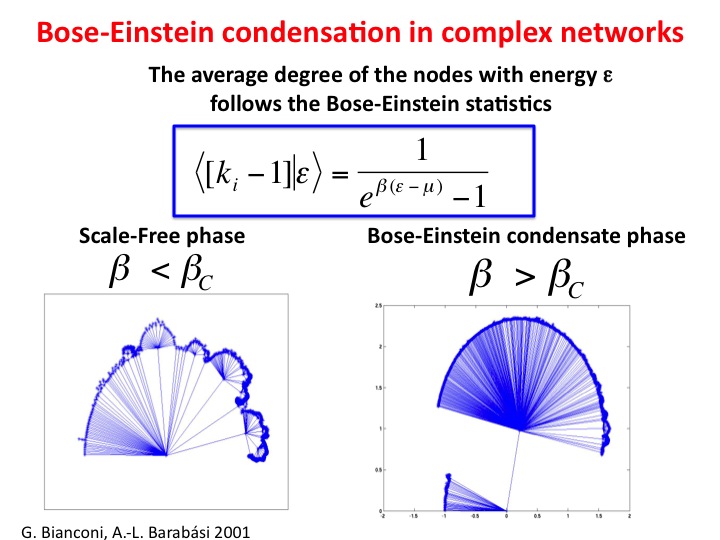Bose-Einstein condensation in complex networks
HOME
BIOGRAPHY
RESEARCH
GROUP AND ALUMNI
CONTACT
BIOGRAPHY
RESEARCH
- MULTILAYER NETWORKS
- NETWORK GEOMETRY
- TEMPORAL NETWORKS
- NETWORK CONTROL
- BIANCONI-BARABASI MODEL
- CONDENSATION TRANSITIONS
- CRITICAL PHENOMENA ON NETWORKS
- SUBGRAPHS: LOOPS AND CLIQUES
- ENTROPIES OF NETWORK ENSEMBLES
- ENTROPIES FOR INFERENCE PROBLEMS
- BIOLOGICAL NETWORKS
GROUP AND ALUMNI
CONTACT
What do the World-Wide-Web and an ecological systems have in common with a quantum Bose system?
The answer to this question might seem surprising, but all these systems might show a condensation phase transition.
If you are a physicist you will know everything about the Bose-Einstein condensation of a Bose system. A Bose-Einstein condensation occurs in a ideal Bose system below the critical temperature Tc. For T < Tc, a finite fraction of all the particles is found in the ground state.
Actually it turns out that condensation transitions are common to many out-of equilibrium and disordered systems as spin-glass, zero range processes and wealth distribution models. In a complex network a condensation occurs when one node acquires a finite fraction of all the links. This is what happens in a competitive complex system described by the BIANCONI-BARABASI MODEL (See figures below).
In an ecological system, in presence of migration of species one species can become dominant and the biodiversity of the ecosystem is strongly reduced. This transition is relevant for studying the role of invasive species in stable ecologies.
Both these transitions can be mapped to the Bose-Einstein condensation in a Bose gas. (Curiosity: There are also evolving networks that can be constructed similarly to the BIANCONI-BARABASI MODEL and can be mapped to a Fermi distributions. These networks are actually trees that evolve through a modified directed percolation process). These model have been recently put under the same comon framework of network geometry with flavor and Complex Quantum Network Manifolds.
The answer to this question might seem surprising, but all these systems might show a condensation phase transition.
If you are a physicist you will know everything about the Bose-Einstein condensation of a Bose system. A Bose-Einstein condensation occurs in a ideal Bose system below the critical temperature Tc. For T < Tc, a finite fraction of all the particles is found in the ground state.
Actually it turns out that condensation transitions are common to many out-of equilibrium and disordered systems as spin-glass, zero range processes and wealth distribution models. In a complex network a condensation occurs when one node acquires a finite fraction of all the links. This is what happens in a competitive complex system described by the BIANCONI-BARABASI MODEL (See figures below).
In an ecological system, in presence of migration of species one species can become dominant and the biodiversity of the ecosystem is strongly reduced. This transition is relevant for studying the role of invasive species in stable ecologies.
Both these transitions can be mapped to the Bose-Einstein condensation in a Bose gas. (Curiosity: There are also evolving networks that can be constructed similarly to the BIANCONI-BARABASI MODEL and can be mapped to a Fermi distributions. These networks are actually trees that evolve through a modified directed percolation process). These model have been recently put under the same comon framework of network geometry with flavor and Complex Quantum Network Manifolds.
Selected publications
-
G. Bianconi and A.L. Barabási,
Bose-Einstein condensation in complex networks
Phys. Rev. Lett. 86 5632 (2001).
(Condensation in complex networks)
-
G. Bianconi,
Emergence of weight-topology correlations in complex scale-free networks
Europhys. Lett. 71, 1029 (2005).
(Condensation in weighted networks)
-
G. Bianconi, L. Ferretti and S. Franz,
Non-neutral theory of biodiversity
Europhys. Lett. 87,28001 (2009).
(Condensation in non-neutral ecologies)
-
B. Bassetti, M. Zarei, M. Cosentino Lagomarsino and G. Bianconi
Statistical Mechanics of the Chinese Restaurant Process: Conditioned Path-integral and Finite-size effects
arxiv:0905.4666
(Condensation phenomena in the "Chinese Restaurant Process")
G. Bianconi, -
G. Bianconi,
Quantum statistics in complex networks Phys. Rev. E 67, 056123 (2002). - (Parallelism between the growing of the fitness model and the growth of the Cayley tree described by Fermi distribution)
-
G. Bianconi and C. Rahmede,
Complex Quatum Network Manifolds in d>2 are Scale-Free
Scientific Reports 5, 13979 (2015).
(Covered in the press Science Daily,Phys.org,La Stampa,MEDIA INAF) -
G. Bianconi and C. Rahmede,
Network geometry with flavor:from complexity to quantum geometry
Physical Review E 93, 032315 (2016).
Growing Cayley trees described by Fermi distribution
Phys. Rev. E 66, 036116 (2002). (Evolution of trees that can be mapped to a Fermi gas)
